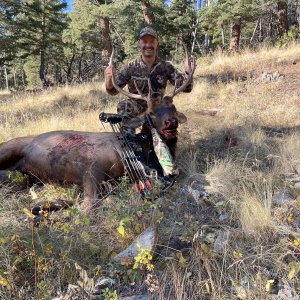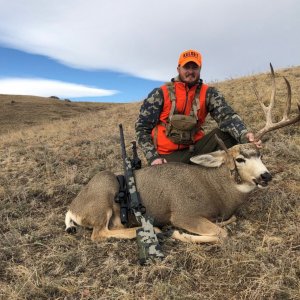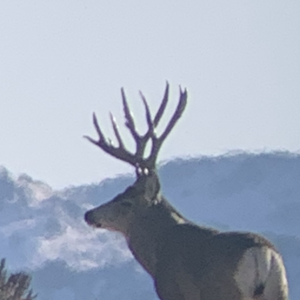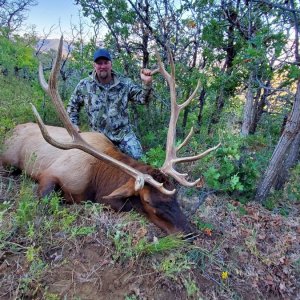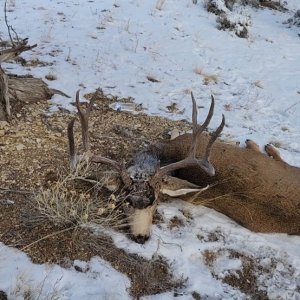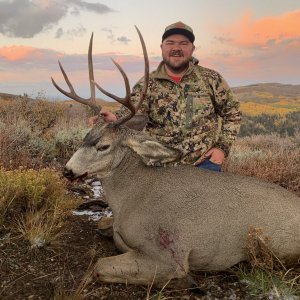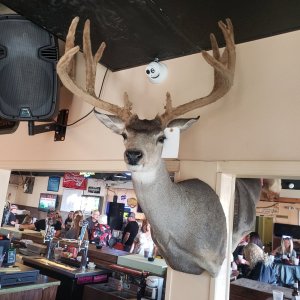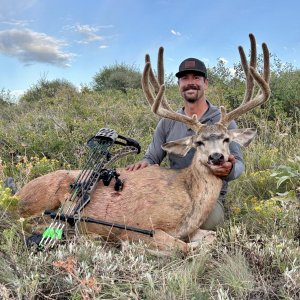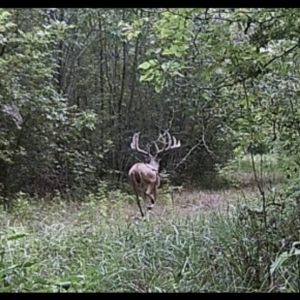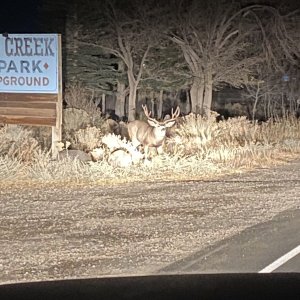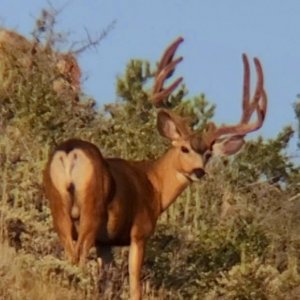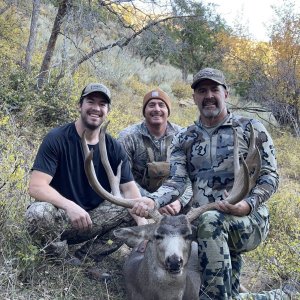LAST EDITED ON Jun-18-14 AT 04:44PM (MST)[p]I got this info from the biologist for the area. It's mostly about the rifle elk hunt, but lots of this info would be helpful to someone wanting to hunt deer in there. Good luck.
BOOK CLIFFS LITTLE CREEK ANY WEAPON ELK HUNT INFORMATION
2014 Hunt #: 3028
Hunt Name: Book Cliffs, Little Creek (Roadless Area)
2014 Season Dates: September 13-21, 2014
Type of Hunt: Limited entry hunt
Harvest Reporting: Mandatory online reporting required 30 days after the hunt ends. Animal does not need to be checked in at a check station or office. You can report harvest information about your hunt online by visiting
http://wildlife.utah.gov/hunting-in-utah/harvest-reporting.or by calling 1-800-221-0659.
Weapon Type: Any Legal Weapon
Hunt Boundary & Map:
http://wildlife.utah.gov/maps/public/details_boundary.php?boundary_id=12
Acreage in the Hunt Unit: 57,048 acres
Land Ownership: The majority of land is managed by SITLA and DWR. There is a large DWR Wildlife Management Area (WMA) known as the Little Creek WMA. This area is managed for wildlife and the DWR encourages hunting on all WMA?s.
Population Objective: 7,500 elk
Current Population Estimate: Our latest population estimate is 4800 elk.
Permit Numbers: 2014
Resident permits: 21
Non-resident permits: 2
Drawing Odds for this unit:
http://wildlife.utah.gov/hunting/biggame/pdf/2013/13_big_game_odds_report.pdf
2013 Hunt Results on this hunt unit:
Hunter Success: 96.2%
Average age of harvested elk: years old
Average number of days hunted: 6.2 days
Average Satisfaction Rating: 4.3 out of 5
Satisfied: 88.5%
Neutral: 7.7%
Unsatisfied: 3.8%
Average bull Harvested: 6 point bull elk with 43.5? antler spread
Campground information:
Please direct all questions regarding maps to the Vernal BLM Field Office (
http://www.blm.gov/ut/st/en/fo/vernal.html) or (435) 781-4400. Suggested Maps: BLM: Vernal, West Water, and they have a general map that labels most of the main roads.
SITLA:
DWR WMA?S:
There are no established campgrounds in this unit, it is a first-come first-served basis. Some hunters prefer to camp at the trailheads. There are DWR cabins in this unit that are not for public use. There is no camping allowed within a quarter mile of a DWR cabin.
The trails are seasonally maintained by the DWR and sportsmen. Don?t expect every trail to be maintained and in good condition. I would bring a saw or an ax to clear trails if needed.
Tribal Access Agreement: The Ute Tribe as agreed to allow sportsmen to access this area across Ute Tribal trust lands. Once you leave the Sego Trailhead parking area and start down the Went Ridge trail you are on Tribal land for the first few miles. There are signs indicating that you have permission from the Tribe to use this route. We ask that you please keep this area clean and stay on the main trail until you are off of Ute Tribal land. This is a privilege and abuse of this area could lead to sportsmen losing this access permit. This hunt excludes all Ute Tribal lands.
Primary Access Points: There are two trailheads for the roadless area, a north and a south. The north access is called the Ten Mile Knoll trailhead. If you take Utah State Road 88, it is located between Vernal and Roosevelt. Follow SR 88 south and it turns into the Seep Ridge Road. The Seep Ridge Rd splits and becomes the Divide Rd. If you take the Divide Rd west, the trailhead is at the start of Steer Ridge. There is a sign at the parking area. It is a large parking area but it can fill up in a hurry with trucks and horse trailers. The Hay Canyon Rd is the main access road on the south side of the Book Cliffs. You can access it from I-70. It is a hard packed dirt/gravel road. The Steer Ridge Rd can be very dangerous if it has been snowing or raining but it can dry out quickly.
The south trail head starts at the top of Sego Canyon. The road starts at Thompson Springs in Grand County and continues up the Sego Canyon Rd; follow it to the end of the road. There is a water trough at the trailhead but it is not always full of water. This trailhead can also fill up with vehicles and trailers. There are no bathrooms or other facilities at either of these trailheads, so plan accordingly.
No ATV and Vehicle Access: This area has strict travel constraints. It is limited to horse and foot travel. Sportsmen should take this into account before they put in for this unit. The Steer Ridge Rd is the northeast boundary of the unit. There are no other roads around this unit.
The Book Cliffs offers a challenging landscape. There are large ridges with steep canyons dividing them.
Safety Considerations: This is a very remote location with some areas with limited access. Cellular phone coverage is very spotty on this hunt unit. Digital cell phones may show several bars but cannot always connect due to the distance to the cell towers. Satellite phones do work in the area. I suggests handheld radios and even a "Spot Tracker" type of satellite messaging device for safety. Make sure someone knows where you plan to camp and when you will return.
The Book Cliffs roadless area has a high bear population. I recommend keeping a clean camp and putting your garbage in a place that is inaccessible to bears. If you do have problems with bears please report them to the DWR Northeast Regional Office as soon as possible (435 781-9453), or local the local dispatch center (435 789-4222).
The Book Cliffs mountain range is one of the more remote areas in Utah. The trails are very steep and challenging. Every year sportsmen have horses and mules die in the roadless area. I would suggest bringing horses that are in good physical condition.
Weather Conditions: The weather on this hunt unit can vary dramatically during the hunting season. Be prepared for rain, lightening, snow, wind and heat. Thunder storms can cause muddy road conditions and flash floods in this region. It is not uncommon to have thunderstorms, flash floods and have trails wash out. Tire chains can come in very handy.
BIOLOGIST NOTES:
Location of Harvest: The roadless area has four main drainages: West Willow Creek, She Creek, Little Creek, and East Willow Creek. All of these drainages are good for camping. The ridges that separate the drainages are: Went Ridge, and Little Creek Ridge. There is a spring on Little Creek Ridge called Three Springs that has good drinking water. This is a popular elk hunting area. Other popular areas to find elk are: Santio Knolls, One Eye Canyon, Rivoguts Canyon, Fish Creek and Dry Fork Canyon.
The elk are found more on the tops of the ridges and come down on the faces and in the canyons to feed and drink. Most archery hunters have the most success early in the hunt sitting remote water holes. As the hunt progress the elk start to rut and become easier to spot and stalk.
Migration Patterns: You will find elk from one end of the roadless area to the other. The elk will start feeling pressured toward the end of the archery hunt with increased rifle hunters scouting for their upcoming hunt. Little Creek Ridge consistently holds a lot of elk. The elk seem to prefer bedding down in the dark conifer timber during the day. Towards the evening the elk will start to work their way onto the burned faces and points of the ridges.
Scouting Tips: A good spotting scope and binoculars are essential for scouting elk in this area. Scouting is most effective late-summer. If you are able to place trail cameras on the remote springs and water holes you will be able to pattern the movements of the bulls. In the hot early fall temperatures I would expect to see the most animals at prime time (1/2 hour before dawn and an hour before sunset). There are several recovering burned areas that have produced large amounts of grass that is excellent for elk. Elk spend a lot of time in the aspen patches where there is a good understory of grass and forbs.
There are very few signs on the trails. I would bring a good map, compass, GPS, and if possible someone who is familiar with the area. If you have never set foot in this unit, it might appear small on a map but on the ground it is quite a large area.
Behavior: Once the bulls shed their velvet they will start to break up from their winter and summer bachelor herds. They will usually water at least two times a day. It is not unusual for elk to graze through the night. As the hunt progresses and if colder weather moves in, the elk will start to come into the rut, or breeding season. Before they start to herd the cows up the bulls are very susceptible to cow elk calls. I have had success calling bulls in from far distances in the unit with the use of a cow call in early September. As elk get closer to the rut they will become more vocal and will start to round up small herds of cows. The larger bulls will usually try to keep their cows away from contending bulls. It is normal to have one herd bull and other bulls surrounding the cows at a distance.
General Information: Most hunters plan on spending a whole week at a time hunting in this remote area. There are plenty of water sources so don't plan on bringing much water in with you. Some hunters who do not have much horse experience camp at the trailheads and hike in and out every day. There are several guides and outfitters who work in this area. I would plan on a very challenging and rewarding hunt. Not many hunters can say they have killed a trophy bull in the true back country like this unit can provide.
Currently there is no domestic livestock grazing in this area, to allow stream bank restoration, and let the landscape heal after the massive fire. There are native Colorado cutthroat trout in most of the streams. There are 30-40 wild horses in this area. I have seen anywhere from 30-70 bison on this unit. It is not uncommon to see black bears in this area. There is usually plenty of feed for horses; most sportsman hobble their horses for a few hours a day.
This area is patrolled quite frequently by DWR personnel. Keep this in mind when you are transporting your game. Try to make it easy to access the permit and tag on the animal.
Dax
There is no such thing as a sure thing in trophy mule deer hunting.

